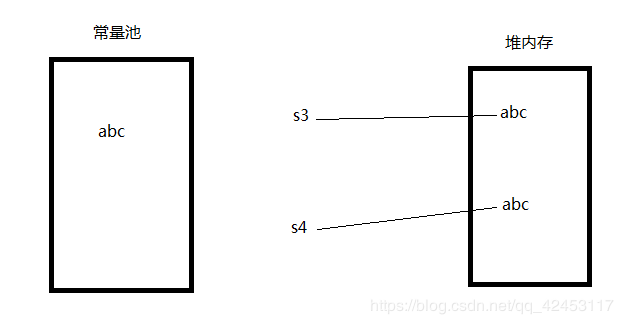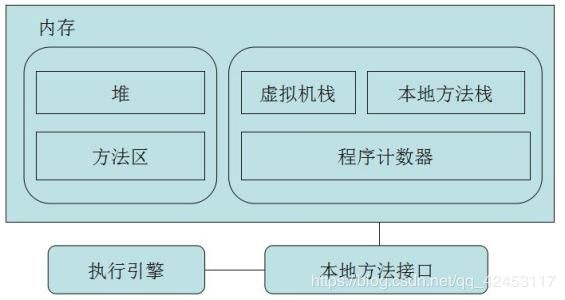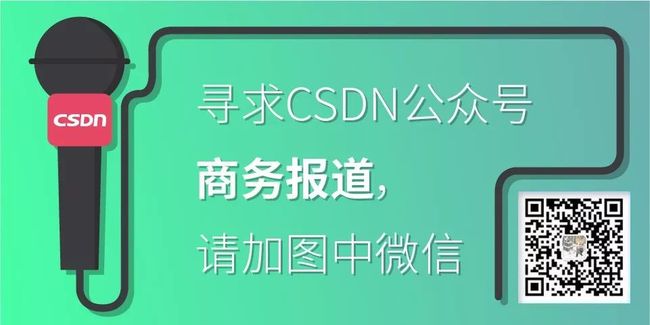深入 Java 源码剖析之字符串常量 | CSDN 博文精选
作者 | #Temptation
责编 | 屠敏
出品 | CSDN 博客
字符串在Java生产开发中的使用频率是非常高的,可见,字符串对于我们而言非常关键。那么从C语言过来的同学会发现,在C中是没有String类型的,那么C语言要想实现字符串就必须使用char数组,通过一个个的字符来组拼成字符串。
Java中是如何实现字符串的
那其实在Java中,关于字符串的实现,其实用的也是char数组,这可以从源码中得到体现。
/** * Initializes a newly created {@code String} object so that it represents * the same sequence of characters as the argument; in other words, the * newly created string is a copy of the argument string. Unless an * explicit copy of {@code original} is needed, use of this constructor is * unnecessary since Strings are immutable. * * @param original * A {@code String} */ public String(String original) { this.value = original.value; this.hash = original.hash; }
public String(String original) {
this.value = original.value;
this.hash = original.hash;
}这是String类的构造方法,而这个value实际上就是char数组。
/** The value is used for character storage. */ private final char value[];
private final char value[];
字符串在内存中的保存方式
我们都知道如何去创建一个字符串,那么, 字符串在内存中的保存方式是怎样的呢?
在内存中有一个区域叫做常量池,而当我们以这样的方式去创建字符串:
String s1 = "abc";String s2 = "abc";"abc";
String s2 = "abc";这个字符串就一定会被保存到常量池中。而Java虚拟机如果发现常量池中已经存在需要创建的字符串中,它就不会重复创建,而是指向那个字符串即可。
String s1 = "abc";String s2 = "abc";System.out.println(s1 == s2);"abc";
String s2 = "abc";
System.out.println(s1 == s2);
所以上述代码段的执行结果一定是true。
但是如果使用new关键字区创建字符串,过程就不太一样了。比如下面的声明:
String s3 = new String("abc");String s4 = new String("abc");new String("abc");
String s4 = new String("abc");过程是这样的:首先将abc保存在常量池中,此时并没有引用,然后new关键字会去创建一个字符串对象,就会在堆内存中创建abc,然后s3变量指向abc。当执行第二句声明时,因为常量池中已经存在abc,所以不会重复创建,而new关键字又会去堆内存开辟空间存放abc,然后s4变量指向abc。
String s3 = new String("abc");String s4 = new String("abc");System.out.println(s3 == s4);new String("abc");
String s4 = new String("abc");
System.out.println(s3 == s4);
所以上述代码段的执行结果一定是false。
字符串驻留
当相同的字符串常量被多次创建时,注意是使用双引号(" ")显式声明时,字符串常量对象会被保存在常量池中,且只会创建一个对象,这就是字符串驻留,这个名词的产生就是为了提升性能。简单提一下,字符串中有一个方法叫做intern();那么这个方法有什么作用呢?该方法会去常量池中寻找当前调用该方法的字符串常量,若找到,则直接返回该字符串对象,若没有,则将当前字符串放入常量池并返回,总之该方法一定会返回字符串。
String s3 = new String("abc");String s4 = new String("abc");System.out.println(s3.intern() == s4.intern());new String("abc");
String s4 = new String("abc");
System.out.println(s3.intern() == s4.intern());所以上述代码段的执行结果一定是true,因为字符串驻留只允许常量池中一个相同字符串的存在。
JVM内存结构
刚才一直在说常量池,那么常量池具体在哪呢?这就要来研究一下JVM的内存结构。
JVM分为堆、栈、方法区,栈又分为本地方法栈和Java栈。
在Java7之前常量池就放在方法区里,而从Java7开始,常量池被移到了堆。这样说过于抽象,我们可以通过代码来感受这一过程。
String s1 = new String("hello") + new String("world");String s2 = "helloworld";System.out.println(s1 == s2);new String("hello") + new String("world");
String s2 = "helloworld";
System.out.println(s1 == s2);上述程序段的执行结果一定是false。因为s1变量在堆中,而s2变量在常量池中,两者肯定不相同。
那么看下面这段代码,猜猜看结果是什么?
String s1 = new String("hello") + new String("world");System.out.println(s1.intern() == s1);new String("hello") + new String("world");
System.out.println(s1.intern() == s1);按照刚才的分析,intern()返回的一定是常量池里的字符串,而s1变量在堆中,它们肯定是不一样的,但运行结果竟然是true。那是不是就能解释常量池在堆中,所以它们指向的是同一个对象呢?其实还不完全是,我们可以继续看一段代码。
String s1 = new String("hello") + new String("world");System.out.println(s1.intern() == s1);String s2 = new String("hello") + new String("world"); System.out.println(s2.intern() == s2);new String("hello") + new String("world");
System.out.println(s1.intern() == s1);
String s2 = new String("hello") + new String("world");
System.out.println(s2.intern() == s2);这段代码的运行结果:
truefalse
false感觉很神奇,让人猜不透,摸不着。别急,下面我们来一起分析一下。
通过这个图来理解一下,首先第一行代码会在常量池中创建hello和world两个字符串,接着在堆中开辟了一个空间存放组合后的字符串helloworld,然后变量s1指向它。我们说intern()会返回常量池中的字符串,那么在常量池中没有helloworld的情况下intern()方法会怎样处理呢?其实它会将对堆中helloworld的引用放入常量池中,此时s1.intern()和s1都指向的是同一个对象,它们是相等的。但是s2在创建的过程中也会在堆中开辟一个空间存放helloworld,使变量s2指向它,而s2.intern()方法在执行的时候发现,helloworld的引用已经存在,所以直接返回,但此时返回的其实是s1变量的引用,那么s2.intern()与s2不相等相信大家能够理解了。
String s1 = new String("hello") + new String("world");System.out.println(s1.intern() == s1);String s2 = new String("hello") + new String("world");System.out.println(s2.intern() == s1);new String("hello") + new String("world");
System.out.println(s1.intern() == s1);
String s2 = new String("hello") + new String("world");
System.out.println(s2.intern() == s1);那么这段程序的输出结果你若是能立马知晓,那么恭喜你,前面的知识点你已基本掌握。执行结果就是:
truetrue
true我们还可以通过一个极端的方法来判断常量池的位置。
List list = new ArrayList();String str = "boom";for(int i = 0;i < Integer.MAX_VALUE;i++) { String temp = str + i; str = temp; list.add(temp.intern()); }new ArrayList();
String str = "boom";
for(int i = 0;i < Integer.MAX_VALUE;i++) {
String temp = str + i;
str = temp;
list.add(temp.intern());
}通过编写这一段程序能够让JVM去不停地将字符串变量存入常量池从而使其内存溢出,内存溢出后控制台信息如下:
Exception in thread "main" java.lang.OutOfMemoryError: Java heap space at java.util.Arrays.copyOfRange(Arrays.java:2694) at java.lang.String.(String.java:203) at java.lang.StringBuilder.toString(StringBuilder.java:405) at com.itcast.test2.StringTest.main(StringTest.java:25)in thread "main" java.lang.OutOfMemoryError: Java heap space
at java.util.Arrays.copyOfRange(Arrays.java:2694)
at java.lang.String.<init>(String.java:203)
at java.lang.StringBuilder.toString(StringBuilder.java:405)
at com.itcast.test2.StringTest.main(StringTest.java:25) 可以看到,控制台信息提示堆内存溢出,这也可以得出常量池的位置是在堆内。
这是Java7及其以后版本的输出信息,当我们将版本切换为Java7之前的版本,同样的代码,输出信息如下:
Exception in thread "main" java.lang.OutOfMemoryError: PermGen space at java.util.Arrays.copyOfRange(Arrays.java:2694) at java.lang.String.(String.java:203) at java.lang.StringBuilder.toString(StringBuilder.java:405) at com.itcast.test2.StringTest.main(StringTest.java:25)in thread "main" java.lang.OutOfMemoryError: PermGen space
at java.util.Arrays.copyOfRange(Arrays.java:2694)
at java.lang.String.<init>(String.java:203)
at java.lang.StringBuilder.toString(StringBuilder.java:405)
at com.itcast.test2.StringTest.main(StringTest.java:25) PermGen space其实就是方法区, 那么其实在JVM中的堆,一般分为三大部分:新生代、老年代、永久代:这个PermGen space就是永久代,也就是方法区,叫法不同而已。
其它问题
继续来探讨一下关于字符串常量的一些其它问题。
String s1 = "hello" + "world";String s2 = "helloworld";System.out.println(s1 == s2);String temp = "hello";String s3 = temp + "world";String s4 = "helloworld";System.out.println(s3 == s4);"hello" + "world";
String s2 = "helloworld";
System.out.println(s1 == s2);
String temp = "hello";
String s3 = temp + "world";
String s4 = "helloworld";
System.out.println(s3 == s4);那么,这两个输出的结果是什么呢?
结果是:
truefalse
false第一个输出为true不难理解,因为s1和s2指向的都是常量池中的helloworld字符串,那么s3和s4难道就不是吗?它还真就不是这样了。s3在创建过程中会将temp保存在堆内存中,所以s3和s4指向的对象不是同一个。
我们可以通过反编译来证实,将这段代码的.class文件进行反编译,结果如下:
String s1 = "helloworld";String s2 = "helloworld"; System.out.println(s1 == s2);String temp = "hello";String s3 = String.valueOf(temp) + "world";String s4 = "helloworld";System.out.println(s3 == s4);"helloworld";
String s2 = "helloworld";
System.out.println(s1 == s2);
String temp = "hello";
String s3 = String.valueOf(temp) + "world";
String s4 = "helloworld";
System.out.println(s3 == s4);我们可以看到,s1和s2的创建过程其实是一模一样的,其实,JVM为了优化速度,当它确定是两个字符串常量进行拼接时,它会在编译器就完成拼接,而并不会去创建对象处理,但是s3的创建要经过temp变量,因为JVM无法在编译期就推测出temp,所以它要通过String对象来进行处理,将temp放入堆内存。
所以,并不是说只有出现new关键字变量才会放入堆内存中。
希望这篇文章能够使你更加深入地理解字符串常量。
声明:本文为 CSDN 博客精选文章,版权归作者所有。
原文:
https://blog.csdn.net/qq_42453117/article/details/97128658
从零开始的 Python 爬虫速成指南,实用!
https://edu.csdn.net/topic/python115?utm_source=csdn_bw
【End】
今日七夕!不取标题,只想娶你
TIOBE 8 月编程语言排行榜:Python 奋力追赶 C,Swift 下跌
被罚 50 亿后,Google 不再强制绑定 Android 默认引擎!
☞ 张一鸣:我用排除法选工作和择偶
☞重磅!AI Top 30+案例评选正式启动☞自然语言处理十问!独家福利☞容器快速入门完全指南☞媒体巨头进军区块链!纽约时报将用区块链技术打击假新闻为什么雷军说“华为不懂研发”?












